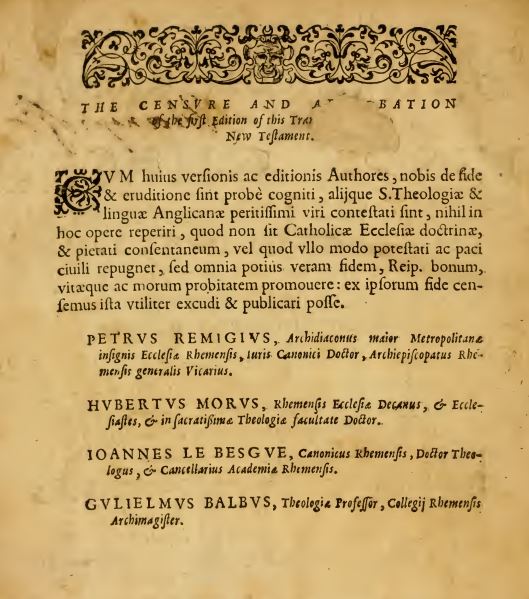Nihil Obstat and Imprimatur for the New Testament written in modern orthography by Burns Oates and Washbourne.
NIHIL OBSTAT
Thomas McLaughlin, S.T.D.
Censor deputatus.
IMPRIMATUR
Edm. Can. Surmont,
Vicarius generalis.
Westmonasterii,
Die 31 Decembris, 1925.1
Also, the 4 Divines of the Douay seminary gave their approval before it was first published in 1582 without objection nor condemnation from
Ecclesiastical authorities. This version comes to us on the authority of certain divines of the Cathedral and College of Rheims and of the
University of Douay, confirmed by the subsequent indirect recognition of English, Scotch, and Irish bishops, and by its general reception by the
faithful.2 The earliest versions of official Imprimaturs and Nihil Obstats I could find were from 1917 as a result of
the Code of Canon Law from 1917. Before then you could see on Catholic Bibles, usually from the 1800s, a page dedicated to Approbations
or approval from local Bishops. The Orginal Rheims New Testament and Douay Old Testament received the requisite approval of their time and so do not need additional modern Ecclesiastical approval.
 3
3
1 Fogny, J. (Trans.). (1925). The 1582 Rheims New Testament. London: Oates Burns & Washbourne.
2 St. Newman, J. H. (1859). Rambler. Retrieved from http://www.newmanreader.org/works/tracts/douayrheims.html
3 Fogny, J. (Trans.). (1582). The Rheims New Testament. Rheims Seminary. Retrieved from https://archive.org/details/newtestamentofie00engl/page/n15/mode/2up